By Denny Rogers – 2018
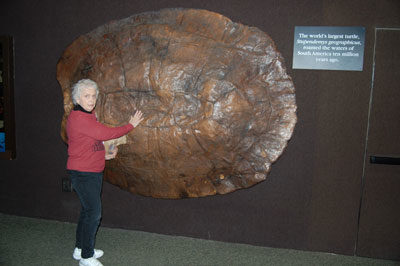
| Misc. Turtle Facts Fossil records show that turtles have been around for at least 250 million years. Turtles found today will generally fall into 3 categories: sea turtles, box turtles or tortoises, and freshwater aquatic or semi-aquatic turtles. Red eared slider turtles are scientifically identified as Trachemys scripta elegans, and are part of a group of similar sub-species generally called pond sliders which include yellow- bellied, red-eared, and Cumberland turtles. They are found naturally from the northern United States south into Brazil. These turtles have a life expectancy of 35 to 40 years, and can become quite social with their owners. Federal law requires that these turtles measure at least 4 inches across the carapace to be legally sold in the United States. Some states have other laws concerning the sale of turtles which may be more restrictive than federal laws. Proper sanitation procedures including hand washing should always be followed when handling turtles. |
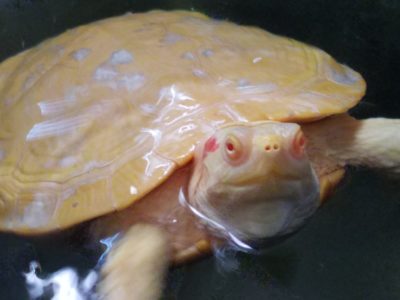
Turtles seem to have almost universal appeal among people. Old and young, male and female, urban and rural, all have fond memories of their interactions with turtles. Almost everywhere I go, when I mention to someone that I raise turtles, they have to tell me about when they had turtles as a child, or that they used to have a pet turtle. I’ve lost track of how many teachers tell me about the turtles they have in their classrooms. Large crowds are attracted to the ocean shore when it is discovered that turtles are in the process of laying eggs, or turtle eggs are hatching. The success of the Mutant Teenage Ninja Turtles has also added to the mystique of keeping turtles.
I’ve been interested in living things for as long as I can remember. My first encounter with aquarium fish occurred before I was in grade school. However, my interest in living creatures wasn’t restricted to just fish. I was finding tadpoles, frogs, toads, crayfish, turtles, snakes, and lizards all the way through grade school and beyond. I’ve also had mice, hamsters, guinea pigs and birds at various times throughout my life. While tropical fish have been the most consistent manifestation of this interest, I have remained interested in other living things well.
In 2010 I found out that a friend in Kansas City was trying to get rid of 2 male albino red eared slider (RES) turtles he had. I had seen them at his house previously, and was fascinated watching them. He had had a group of 2 males and one female, but because of an unfortunate accident involving a filter intake, his female had drowned. He was upset and discouraged by this turn of events, and decided to sell the 2 males. I called him, and discussed the situation which eventually resulted in my getting these 2 turtles in June of 2010. My intention was to find another female albino RES and eventually breed them to get albino RES babies. This turned out to be much more difficult than I had anticipated. I couldn’t find an adult female albino RES anywhere. In addition, everywhere I looked for albino RES hatchlings, they were sold out despite an asking price between $200-300. It soon became obvious that I also needed a “Plan B”.
I decided that I would approach this project from 2 directions. The first path was to keep looking for a female albino RES. I had no reason to believe that the genetics in breeding an albino turtle would be any different than virtually all other species when dealing with a recessive gene. There are a few other animals where albinism is dominant, most notably Kribensis cichlids from West Africa, but typically the gene for albino is recessive. This meant that if I could find another female albino RES, I should get 100% albino progeny.
Plan B involved getting some regularly colored females and breeding them to my albino RES males. All young produced from this pairing would carry one copy of the albino gene, but would look the same as the females (wild type). I would then have to either breed this first generation brother to sister, or breed them back to the original albino RES males. Brother to sister matings should result in 25% albino progeny, but the remaining normal looking turtles would be a mix of both the heterozygous individuals (carrying one copy of the albino gene) and the others not carrying the albino gene at all.
At this point I decided that I would eventually mate the first generation hatchling females back to the original albino RES males. The one thing I haven’t mentioned is the fact that it would take at least 4 to 6 years for the first generation hatchlings to be big enough to determine the sex, and to be mature enough to breed. This was not going to be a short term project. I had to be prepared to wait a long time to see any albino babies.
I found 2 wild type females during the summer of 2010. One was from one of the local big box stores and was just 4 inches shell length, and the other was from a teacher who was getting rid of a female she had been keeping in her classroom. This one was probably 5-6 inches when we got her. Then the wait began. I eventually housed all our turtles in 300 gallon stock tanks. One stock tank was outdoors for the summer and another was in the garage to house them over the winter. The outdoor tank became very green with algae, and in the fall when we were transferring them inside, I couldn’t find one of the females. I wasn’t sure if she had escaped or had fallen victim to one of our local predators. The next spring as I was walking past some other stock tanks I had outside, I noticed a head disappearing under water. It was our lost female. She had over-wintered outside with no ill effects.

My wife, while being very tolerant of my aquarium hobby, had never been interested in actively participating in my fish endeavors. Once I got the turtles, I began to notice she was much more interested in the turtles than she had ever been with the fish. She would actually go down to feed them, and was very interested in the turtle’s social interaction with people (mostly with herself).
Each year we kept looking for eggs, but there was no indication they were laying any in the nest boxes we had provided. Finally in 2014, we found one egg which we removed to incubate. By that time we were aware that the eggs typically incubated for 60-90 days prior to hatching. The sex of the hatchlings is determined by the incubation temperature with temperatures closer to 85 degrees F producing mostly females, and temperatures under 80 degrees F producing mostly males. Since this was our first experience trying to hatch a turtle egg, we probably didn’t provide ideal conditions for hatching. After waiting more than 90 days, we finally cut into the egg and found an embryo. It was dead, but it did show us that the albino males were capable of fertilizing the females.
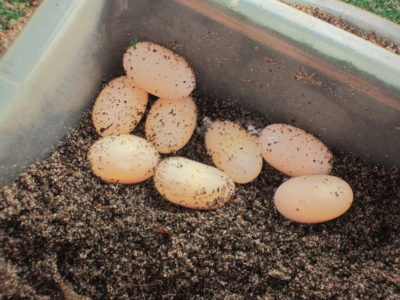
By 2015 we were more knowledgeable of the needed conditions to hatch turtle eggs, and we ended up collecting about 25 eggs. The batches were typically from 4 to 9 eggs from each clutch. Our hatch rate was somewhere around 40-50%. We decided to retain all of these hatchlings to try to get some females to eventually breed back to the albino RES males. In 2016 we were able to collect another 45 eggs, and hatched 23 babies.
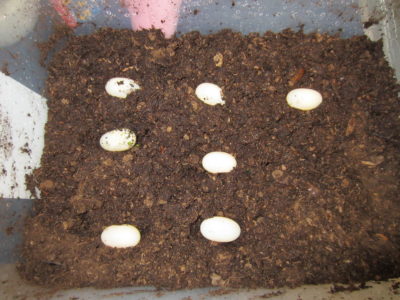
We decided in 2017 that we didn’t need the 2 wild type females any longer, since we were running out of space to keep all of our turtles. By that time our wild type females were around 10-11 inches across their shells, but fortunately we was able to re-home them. We also spent a long time trying to determine whether we could successfully sex the turtles born in 2015. We finally kept 5 for our breeding stock (later discovering that one was a male). We only wanted to keep females from this bunch so there would be no question what the genetic makeup was for any hatchlings born from that time forward. At the present time, all of our turtles are either albino or carry the gene for albino.

Going back to my original plan, we eventually found a female albino RES that was born in 2012. We received her in 2013 at which time she weighed 101 grams. For comparisons sake, our wild females weighed around 1200-1400 grams as adults. We’ve been raising her ever since getting her in 2013, and she is now bigger than both my albino males. We had hopes that she might start laying eggs this past summer (2018), but in spite of some courting activity in the spring by the males, we didn’t end up with any eggs. Needless to say we’ll be watching her very closely in 2019. At the same time, at least one of the 2015 females who carries the albino gene is now as big as the males, so hopefully she may be mature enough to start laying eggs in 2019 also. We are really anxious to have albino babies.

Should you ever decide to keep turtles, there are a few things to keep in mind. They live a very long time, need relatively large habitats, and require a lot of filtration. In addition, you will have to provide a docking area for them to get out of the water, as well as a heat bulb and a UVB bulb for basking. If you are going to try to breed your turtles, you will also need to provide nesting boxes on the docking platform where they can lay their eggs. Our turtles often were very good at laying their eggs without leaving any sign that they had dug a hole, and then covering them up. If the turtles are kept outside over the summer, you should also make arrangements to bring them inside over the winter. While they may survive a winter outside, depending on your location, the risk of having problems up to and including death are greatly increased.
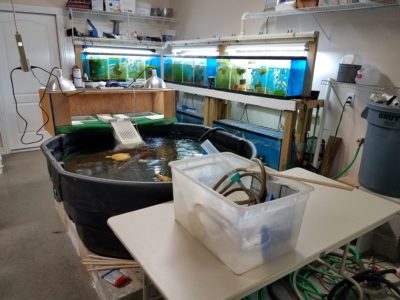
Given proper care and feeding, turtles can be an exciting and endearing educational pet for many years to come.
